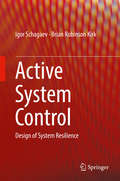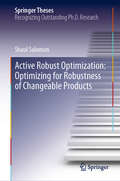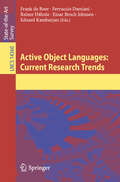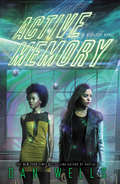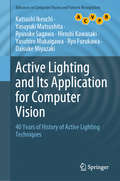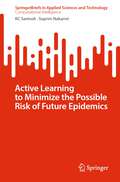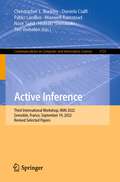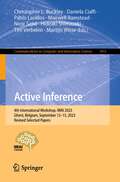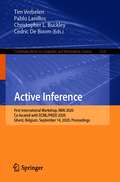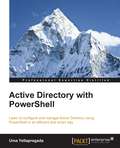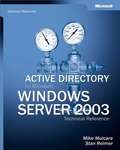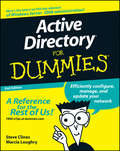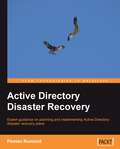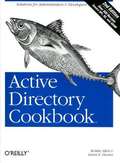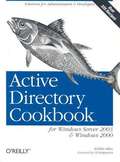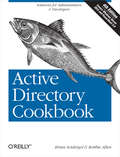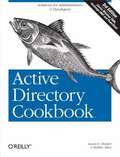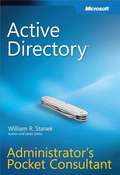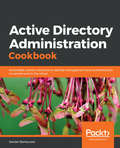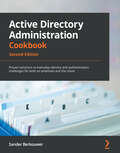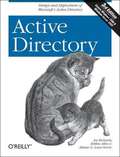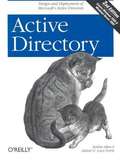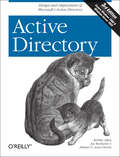- Table View
- List View
Active System Control: Design of System Resilience
by Igor Schagaev Brian Robinson KirkThis book introduces an approach to active system control design and development to improve the properties of our technological systems. It extends concepts of control and data accumulation by explaining how the system model should be organized to improve the properties of the system under consideration. The authors define these properties as reliability, performance and energy-efficiency, and self-adaption. They describe how they bridge the gap between data accumulation and analysis in terms of interpolation with the real physical models when data used for interpretation of the system conditions. The authors introduce a principle of active system control and safety - an approach that explains what a model of a system should have, making computer systems more efficient, a crucial new concern in application domains such as safety critical, embedded and low-power autonomous systems like transport, healthcare, and other dynamic systems with moving substances and elements. On a theoretical level, this book further extends the concept of fault tolerance, introducing a system level of design for improving overall efficiency. On a practical level it illustrates how active system approach might help our systems be self-evolving.
Active Robust Optimization: Optimizing for Robustness of Changeable Products (Springer Theses)
by Shaul SalomonThis book presents a novel framework, known as Active Robust Optimization, which provides the tools for evaluating, comparing and optimizing changeable products. Since any product that can change its configuration during normal operation may be considered a “changeable product,” the framework is widely applicable. Further, the methodology enables designers to use adaptability to deal with uncertainties and so avoid over-conservative designs. Offering a comprehensive overview of the framework, including its unique features, such as its ability to optimally respond to uncertain situations, the book also defines a new class of optimization problem and examines the effects of changes in various parameters on their solution. Lastly, it discusses innovative approaches for solving the problem and demonstrates these with two examples from different fields in engineering design: optimization of an optical table and optimization of a gearbox.
Active Object Languages: Current Research Trends (Lecture Notes in Computer Science #14360)
by Einar Broch Johnsen Frank De Boer Reiner Hähnle Ferruccio Damiani Eduard KamburjanActive Objects are a programming paradigm that supports a non-competitive, data-driven concurrency model. This renders active object languages to be well-suited for simulation, data race-free programming, and formal verification. Concepts from active objects made their way into languages such as Rust, ABS, Akka, JavaScript, and Go. This is the first comprehensive state-of-art overview on the subject, the invited contributions are written by experts in the areas of distributed systems, formal methods, and programming languages.
Active Memory
by Dan WellsFrom Dan Wells, author of the New York Times bestselling Partials Sequence, comes the third installment in a thrilling sci-fi noir series set in 2050 Los Angeles.Even in a world where technology connects everyone’s minds, it would seem that some secrets can still remain hidden.For all the mysteries teen hacker Marisa Carneseca has solved, one has always eluded her: When she was two years old, she was in a car accident in which she lost her arm and a mob boss’s wife, Zenaida de Maldonado, lost her life. No one can tell her what she was doing in that car, or how it led to the feud between the Carnesecas and the Maldonados. The secrets from the past rise violently to the surface when Zenaida's freshly severed hand shows up at the scene of a gangland shooting. If Zenaida is—or was—still alive, it means there’s even more about Marisa’s past that she doesn’t know.And when everyone from Los Angeles gangs to the world’s largest genetic engineering firms becomes involved in the case, it’s clear there’s more happening under the surface than anyone cares to admit.The truth is out there, and Marisa will have to thread together lost friends, corporate assassins, a gang lord’s digital brain, and what might be a literal ghost from the past in order to find it.
Active Lighting and Its Application for Computer Vision: 40 Years of History of Active Lighting Techniques (Advances in Computer Vision and Pattern Recognition)
by Katsushi Ikeuchi Yasuyuki Matsushita Ryusuke Sagawa Hiroshi Kawasaki Yasuhiro Mukaigawa Ryo Furukawa Daisuke MiyazakiThis book describes active illumination techniques in computer vision. We can classify computer vision techniques into two classes: passive and active techniques. Passive techniques observe the scene statically and analyse it as is. Active techniques give the scene some actions and try to facilitate the analysis. In particular, active illumination techniques project specific light, for which the characteristics are known beforehand, to a target scene to enable stable and accurate analysis of the scene. Traditional passive techniques have a fundamental limitation. The external world surrounding us is three-dimensional; the image projected on a retina or an imaging device is two-dimensional. That is, reduction of one dimension has occurred. Active illumination techniques compensate for the dimensional reduction by actively controlling the illumination. The demand for reliable vision sensors is rapidly increasing in many application areas, such as robotics and medical image analysis. This book explains this new endeavour to explore the augmentation of reduced dimensions in computer vision. This book consists of three parts: basic concepts, techniques, and applications. The first part explains the basic concepts for understanding active illumination techniques. In particular, the basic concepts of optics are explained so that researchers and engineers outside the field can understand the later chapters. The second part explains currently available active illumination techniques, covering many techniques developed by the authors. The final part shows how such active illumination techniques can be applied to various domains, describing the issue to be overcome by active illumination techniques and the advantages of using these techniques. This book is primarily aimed at 4th year undergraduate and 1st year graduate students, and will also help engineers from fields beyond computer vision to use active illumination techniques. Additionally, the book is suitable as course material for technical seminars.
Active Learning to Minimize the Possible Risk of Future Epidemics (SpringerBriefs in Applied Sciences and Technology)
by KC Santosh Suprim NakarmiFuture epidemics are inevitable, and it takes months and even years to collect fully annotated data. The sheer magnitude of data required for machine learning algorithms, spanning both shallow and deep structures, raises a fundamental question: how big data is big enough to effectively tackle future epidemics? In this context, active learning, often referred to as human or expert-in-the-loop learning, becomes imperative, enabling machines to commence learning from day one with minimal labeled data. In unsupervised learning, the focus shifts toward constructing advanced machine learning models like deep structured networks that autonomously learn over time, with human or expert intervention only when errors occur and for limited data—a process we term mentoring. In the context of Covid-19, this book explores the use of deep features to classify data into two clusters (0/1: Covid-19/non-Covid-19) across three distinct datasets: cough sound, Computed Tomography (CT) scan, and chest x-ray (CXR). Not to be confused, our primary objective is to provide a strong assertion on how active learning could potentially be used to predict disease from any upcoming epidemics. Upon request (education/training purpose), GitHub source codes are provided.
Active Inference: Third International Workshop, IWAI 2022, Grenoble, France, September 19, 2022, Revised Selected Papers (Communications in Computer and Information Science #1721)
by Christopher L. Buckley Daniela Cialfi Pablo Lanillos Maxwell Ramstead Noor Sajid Hideaki Shimazaki Tim VerbelenThis volume constitutes the papers of the 3rd International Workshop on Active Inference, IWAI 2022, held in Grenoble, France, in conjunction with ECML/PKDD, on September 19, 2022.The 25 revised full papers presented in this book were carefully reviewed and selected from 31 submissions.
Active Inference: 4th International Workshop, IWAI 2023, Ghent, Belgium, September 13–15, 2023, Revised Selected Papers (Communications in Computer and Information Science #1915)
by Christopher L. Buckley Daniela Cialfi Pablo Lanillos Maxwell Ramstead Noor Sajid Hideaki Shimazaki Tim Verbelen Martijn WisseThis volume constitutes the papers of the 4th International Workshop on Active Inference, IWAI 2023, held in Ghent, Belgium on September 2023.The 17 full papers included in this book were carefully reviewed and selected from 34 submissions. They were organized in topical sections as follows: active inference and robotics; decision-making and control; active inference and psychology; from theory to implementation; learning representations for active inference; and theory of learning and inference.
Active Inference: First International Workshop, IWAI 2020, Co-located with ECML/PKDD 2020, Ghent, Belgium, September 14, 2020, Proceedings (Communications in Computer and Information Science #1326)
by Tim Verbelen Pablo Lanillos Christopher L. Buckley Cedric De BoomThis book constitutes the refereed proceedings of the First International Workshop on Active Inference, IWAI 2020, co-located with ECML/PKDD 2020, held in Ghent, Belgium, in September 2020. The 13 full papers along with 6 short papers were thoroughly reviewed and selected from 25 submissions. They are organized in the topical sections on active inference and continuous control; active inference and machine learning; active inference: theory and biology.
Active Directory with PowerShell
by Uma YellapragadaIf you are looking to automate repetitive tasks in Active Directory management using the PowerShell module, then this book is for you. Any experience in PowerShell would be an added advantage.
Active Directory® for Microsoft® Windows Server® 2003 Technical Reference
by Mike Mulcare Stan ReimerGet the focused, in-depth technical expertise you need to implement and optimize your Microsoft directory services infrastructure. As two Active Directory® experts guide you through advanced design and deployment issues for the Windows® Server 2003 environment, you'll develop a thorough understanding of the underlying concepts, architectural components, and real-world functionality of Active Directory directory service. Whether you're upgrading from Microsoft Windows NT® 4.0 or later, or performing a clean installation, you'll learn the best ways to exploit Active Directory capabilities for your organization--and deliver new levels of network performance and productivity. Get the technical drill-down you need to: Install, upgrade, or migrate to Active Directory Learn essential design considerations for DNS Design Active Directory structure--forests, domains, sites, and OUs Manage Active Directory objects, including users and groups Optimize domain controller data replication Use group policies to deploy software and manage desktops Implement authentication, Kerberos, and other security features and tools Monitor Active Directory replication and domain controller performance, and manage the Active Directory database Perform critical maintenance and plan for disaster recovery
Active Directory For Dummies
by Steve Clines Marcia LoughryWhether you're new to Active Directory (AD) or a savvy system administrator looking to brush up on your skills, Active Directory for Dummies, 2nd Edition will steer you in the right direction! Since its original release, Microsoft's implementation of the lightweight directory access protocol (LDAP) for the Windows Server line of networking software has become one of the most popular directory service products in the world. If you are involved with the design and support of Microsoft directory services and/or solutions, you really need this book!You'll understand the basics of AD and utilize its structures to simplify your life and secure your digital environment. You'll discover how to exert fine-grained control over groups, assets, security, permissions, and policies on a Windows network and efficiently configure, manage, and update the network. You'll find new and updated material on security improvements, significant user interface changes, and updates to the AD scripting engine, password policies, accidental object deletion protection, and more. You will learn how to:Navigate the functions and structures of ADUnderstand business and technical requirements and determine goalsBecome familiar with physical components like site links, network services, and site topologyManage and monitor new features, AD replication, and schema managementMaintain AD databasesAvoid common AD mistakes that can undermine network securityComplete with lists of the ten most important points about AD, and ten cool Web resources, and ten troubleshooting tips, Active Directory For Dummies, 2nd Edition is your one-stop guide to setting up, working with, and making the most of Active Directory.Note: CD-ROM/DVD and other supplementary materials are not included as part of eBook file.
Active Directory Disaster Recovery
by Florian RommelThe book is a combined planning/response-focused book and can be read end to end but also is designed so that the second half can be read standalone, should disaster have struck already. This book is targeted at network security professionals who find themselves charged with creating an Active Directory Disaster Recovery plan or who want to quickly recover once disaster has struck. This book expects you to be familiar with the basics of Active Directory and Windows Servers.
Active Directory Cookbook, 2nd Edition
by Robbie Allen Laura E. HunterIf you're among those looking for practical hands-on support, help is here with Active Directory Cookbook , Second Edition, a unique problem-solving guide that offers quick answers for Active Directory and updated for Window Server 2003 SP1 and R2 versions. The book contains hundreds of step-by-step solutions for both common and uncommon problems that you're likely to encounter with Active Directory on a daily basis--including recipes to deal with the Lightweight Directory Access Protocol (LDAP), ADAM, multi-master replication, Domain Name System (DNS), Group Policy, the Active Directory Schema, and many other features. Author Robbie Allen, a Technical Leader at Cisco Systems, MVP for Directory Services, and co-author of Active Directory , Third Edition and Laura E. Hunter, MVP for Windows Server-Networking and author of several books, have based this collection of troubleshooting recipes on their own experience, along with input from Windows administrators. Each recipe includes a discussion explaining how and why the solution works, so you can adapt the problem-solving techniques to similar situations. This best selling book provides solutions to over 300 problems commonly encountered when deploying, administering, and automating Active Directory to manage users in Windows 2000 and Windows Server 2003. The recipes include: creating domains and trusts renaming a domain controller finding users whose passwords are about to expire applying a security filter to group policy objects checking for potential replication problems restricting hosts from performing LDAP queries viewing DNS server performance statistics This Cookbook is a perfect companion to Active Directory , Third Edition, the tutorial that experts hail as the best source for understanding Microsoft's directory service. While Active Directory provides the big picture, Active Directory Cookbook gives you quick solutions you need to cope with day-to-day dilemmas. Together, these books supply the knowledge and tools so you can get the most out of Active Directory to manage users, groups, computers, domains, organizational units, and security policies on your network.
Active Directory Cookbook
by Robbie AllenThis book contains hundreds of step-by-step solutions for both common and uncommon problems that you might encounter with Active Directory -- including recipes to deal with the Lightweight Directory Access Protocol (LDAP), multi-master replication, Domain Name System (DNS), Group Policy, the Active Directory Schema, and many other features. Author Robbie Allen, a Senior Systems Architect at Cisco Systems and co-author of our Active Directory tutorial, based this collection of troubleshooting recipes on his own experience, along with input from Windows administrators throughout the industry. Each recipe includes a discussion to explain how and why the solution works, so you can adapt the problem-solving techniques to similar situations.
Active Directory Cookbook
by Robbie AllenThose of you who run networks on Windows 2000 know the benefits of using Active Directory for managing user information and permissions. You also know what a bear it can be. The newer version included with Windows Server 2003 has over 100 new and updated features to simplify deployment, but once it's in place many system administrators still find Active Directory challenging. If you're among those looking for practical hands-on support, help is here with our new Active Directory Cookbook for Windows Server 2003 and Windows 2000, a unique problem-solving guide that offers quick answers for both versions of the directory. The book contains hundreds of step-by-step solutions for both common and uncommon problems that you might encounter with Active Directory on a daily basis--including recipes to deal with the Lightweight Directory Access Protocol (LDAP), multi-master replication, Domain Name System (DNS), Group Policy, the Active Directory Schema, and many other features. Author Robbie Allen, a Senior Systems Architect at Cisco Systems and co-author of our Active Directory tutorial, based this collection of troubleshooting recipes on his own experience, along with input from Windows administrators throughout the industry. Each recipe includes a discussion to explain how and why the solution works, so you can adapt the problem-solving techniques to similar situations. If your company is considering an upgrade from Windows NT or 2000 to Windows Server 2003, the Active Directory Cookbook for Windows Server 2003 and Windows 2000 will help reduce the time and trouble it takes to configure and deploy Active Directory for your network. This Cookbook is also a perfect companion to Active Directory, the tutorial that experts hail as the best source for understanding Microsoft's network directory service. While Active Directory provides the big picture, Active Directory Cookbook for Windows Server 2003 and Windows 2000 gives you the quick solutions you need to cope with day-to-day dilemmas. Together, these books supply the knowledge and tools so you can get the most out of Active Directory to manage users, groups, computers, domains, organizational units, and security policies on your network.
Active Directory Cookbook: Solutions for Administrators & Developers (Cookbooks (o'reilly) Ser.)
by Robbie Allen Brian SvidergolWhen you need practical hands-on support for Active Directory, the updated edition of this extremely popular Cookbook provides quick solutions to 450 common (and uncommon) problems you might encounter when deploying, administering, and automating Microsoft's network directory service. Updated for Windows Server 2012, Windows 8, and Exchange 2013, the fourth edition offers troubleshooting recipes based on valuable input from Windows administrators. You'll find solutions for the Lightweight Directory Access Protocol (LDAP), AD LDS (Active Directory Lightweight Directory Services), multi-master replication, Domain Name System (DNS), Group Policy, the Active Directory Schema, and many other features. The Active Directory Cookbook will help you: Perform Active Directory tasks from the command line Use PowerShell to automate Active Directory tasks Manage new Active Directory features, such as the Active Directory Recycle Bin, Group Managed Service Accounts, fine-grained password policies, and more Create domains and trusts Locate users whose passwords are about to expire Apply a security filter to group policy objects Check for potential replication problems Restrict hosts from performing LDAP queries View DNS server performance statistics
Active Directory Cookbook
by Laura E. Hunter Robbie AllenWhen you need practical hands-on support for Active Directory, the updated edition of this extremely popular Cookbook provides quick solutions to more than 300 common (and uncommon) problems you might encounter when deploying, administering, and automating Microsoft's network directory service. For the third edition, Active Directory expert Laura E. Hunter offers troubleshooting recipes based on valuable input from Windows administrators, in addition to her own experience. You'll find solutions for the Lightweight Directory Access Protocol (LDAP), ADAM (Active Directory Application Mode), multi-master replication, Domain Name System (DNS), Group Policy, the Active Directory Schema, and many other features. The Active Directory Cookbook will help you: Perform Active Directory tasks from the command line Use scripting technologies to automate Active Directory tasks Manage new Active Directory features, such as Read-Only Domain Controllers, fine-grained password policies, and more Create domains and trusts Locate users whose passwords are about to expire Apply a security filter to group policy objects Check for potential replication problems Restrict hosts from performing LDAP queries View DNS server performance statistics Each recipe includes a discussion explaining how and why the solution works, so you can adapt the problem-solving techniques to similar situations. Active Directory Cookbook is ideal for any IT professional using Windows Server 2008, Exchange 2007, and Identity Lifecycle Manager 2007, including Active Directory administrators looking to automate task-based solutions."It is rare for me to visit a customer site and not see a copy of Active Directory Cookbook on a shelf somewhere, which is a testament to its usefulness. The Cookbook takes the pain out of everyday AD tasks by providing concise, clear and relevant recipes. The fact that the recipes are provided using different methods (graphical user interface, command line and scripting) means that the book is suitable for anyone working with AD on a day-to-day basis. The introduction of PowerShell examples in this latest edition will be of particular interest for those looking to transition from VBScript. Laura has also done a great job in extending the Cookbook in this edition to encompass the broad range of changes to AD in Windows Server 2008." --Tony Murray, Founder of Activedir.org and Directory Services MVP"If you already understand Active Directory fundamentals and are looking for a quick solution to common Active Directory related tasks, look no further, you have found the book that you need." --joe Richards, Directory Services MVP"The Active Directory Cookbook is the real deal... a soup-to-nuts catalog of every administrative task an Active Directory administrator needs to perform. If you administer an Active Directory installation, this is the very first book you have to put on your shelf." --Gil Kirkpatrick, Chief Architect, Active Directory and Identity Management, Quest Software and Directory Services MVP
Active Directory® Administrator's Pocket Consultant
by William R. StanekPortable and precise, this pocket-sized guide delivers immediate answers for the day-to-day administration of Active Directory in Windows Server 2008. Zero in on core support and maintenance tasks using quick-reference tables, instructions, and lists. You'll get the focused information you need to solve problems and get the job done--whether at your desk or in the field! Get fast facts to: Install forests, domain trees, and child domains Add and remove writable domain controllers and deploy read-only controllers Configure, maintain, and troubleshoot global catalog servers Maintain directory and data integrity using operations masters Evaluate sites, subnets, and replication before expanding a network Establish a trust relationship between domains and between forests Maintain and recover Active Directory Domain Services Employ essential command-line utilities
Active Directory Administration Cookbook: Actionable, proven solutions to identity management and authentication on servers and in the cloud
by Sander BerkouwerLearn the intricacies of managing Azure AD, Azure AD Connect as well as Active Directory for administration on cloud and Windows Server 2019Key FeaturesExpert solutions for the federation, certificates, security, and monitoring with Active DirectoryExplore Azure AD and AD Connect for effective administration on cloudAutomate security tasks using Active Directory and PowerShellBook DescriptionActive Directory is an administration system for Windows administrators to automate network, security and access management tasks in the Windows infrastructure.This book starts off with a detailed focus on forests, domains, trusts, schemas and partitions. Next, you learn how to manage domain controllers, organizational units and the default containers. Going forward, you deep dive into managing Active Directory sites as well as identifying and solving replication problems. The next set of chapters covers the different components of Active Directory and discusses the management of users, groups and computers. You also go through recipes that help you manage your Active Directory domains, manage user and groups objects and computer accounts, expiring group memberships and group Managed Service Accounts with PowerShell. You learn how to work with Group Policy and how to get the most out of it. The last set of chapters covers federation, security and monitoring. You will also learn about Azure Active Directory and how to integrate on-premises Active Directory with Azure AD. You learn how Azure AD Connect synchronization works, which will help you manage Azure AD.By the end of the book, you have learned in detail about Active Directory and Azure AD, too.What you will learnManage new Active Directory features, such as the Recycle Bin, group Managed Service Accounts, and fine-grained password policiesWork with Active Directory from the command line and use Windows PowerShell to automate tasksCreate and remove forests, domains, and trustsCreate groups, modify group scope and type, and manage membershipsDelegate control, view and modify permissionsOptimize Active Directory and Azure AD in terms of securityWho this book is forThis book will cater to administrators of existing Active Directory Domain Services environments and/or Azure AD tenants, looking for guidance to optimize their day-to-day effectiveness. Basic networking and Windows Server Operating System knowledge would come in handy.
Active Directory Administration Cookbook: Proven solutions to everyday identity and authentication challenges for both on-premises and the cloud, 2nd Edition
by Sander BerkouwerSimplified actionable recipes for managing Active Directory and Azure AD, as well as Azure AD Connect, for administration on-premise and in the cloud with Windows Server 2022Key FeaturesExpert solutions for name resolution, federation, certificates, and security with Active DirectoryExplore Microsoft Azure AD and Azure AD Connect for effective administration on the cloudAutomate security tasks using Active Directory tools and PowerShellBook DescriptionUpdated to the Windows Server 2022, this second edition covers effective recipes for Active Directory administration that will help you leverage AD's capabilities for automating network, security, and access management tasks in the Windows infrastructure.Starting with a detailed focus on forests, domains, trusts, schemas, and partitions, this book will help you manage domain controllers, organizational units, and default containers. You'll then explore Active Directory sites management as well as identify and solve replication problems. As you progress, you'll work through recipes that show you how to manage your AD domains as well as user and group objects and computer accounts, expiring group memberships, and Group Managed Service Accounts (gMSAs) with PowerShell. Once you've covered DNS and certificates, you'll work with Group Policy and then focus on federation and security before advancing to Azure Active Directory and how to integrate on-premise Active Directory with Azure AD. Finally, you'll discover how Microsoft Azure AD Connect synchronization works and how to harden Azure AD.By the end of this AD book, you'll be able to make the most of Active Directory and Azure AD Connect.What you will learnManage the Recycle Bin, gMSAs, and fine-grained password policiesWork with Active Directory from both the graphical user interface (GUI) and command lineUse Windows PowerShell to automate tasksCreate and remove forests, domains, domain controllers, and trustsCreate groups, modify group scope and type, and manage membershipsDelegate, view, and modify permissionsSet up, manage, and optionally decommission certificate authoritiesOptimize Active Directory and Azure AD for securityWho this book is forThis book is for administrators of existing Active Directory Domain Service environments as well as for Azure AD tenants looking for guidance to optimize their day-to-day tasks. Basic networking and Windows Server Operating System knowledge will be useful for getting the most out of this book.
Active Directory, 3rd Edition
by Robbie Allen Joe Richards Alistair G. Lowe-NorrisWorking with Microsoft's network directory service for the first time can be a headache for system and network administrators, IT professionals, technical project managers, and programmers alike. This authoritative guide is meant to relieve that pain. Instead of going through the graphical user interface screen by screen, O'Reilly's bestselling Active Directory tells you how to design, manage, and maintain a small, medium, or enterprise Active Directory infrastructure. Fully updated to cover Active Directory for Windows Server 2003 SP1 and R2, this third edition is full of important updates and corrections. It's perfect for all Active Directory administrators, whether you manage a single server or a global multinational with thousands of servers. Active Directory, 3rd Edition is divided into three parts. Part I introduces much of how Active Directory works, giving you a thorough grounding in its concepts. Some of the topics include Active Directory replication, the schema, application partitions, group policies, and interaction with DNS. Part II details the issues around properly designing the directory infrastructure. Topics include designing the namespace, creating a site topology, designing group policies for locking down client settings, auditing, permissions, backup and recovery, and a look at Microsoft's future direction with Directory Services. Part III covers how to create and manipulate users, groups, printers, and other objects that you may need in your everyday management of Active Directory. If you want a book that lays bare the design and management of an enterprise or departmental Active Directory, then look no further. Active Directory, 3rd Edition will quickly earn its place among the books you don't want to be without.
Active Directory, 2nd Edition
by Robbie Allen Alistair G. Lowe-NorrisActive Directory, 2nd Edition, provides system and network administrators, IT professionals, technical project managers, and programmers with a clear, detailed look at Active Directory for both Windows 2000 and Windows Server 2003. Active Directory, 2nd Edition will guide you through the maze of concepts, design issues and scripting options enabling you to get the most out of your deployment.
Active Directory, 2nd Edition
by Robbie Allen Alistair G. Lowe-NorrisWhen Microsoft introduced Windows 2000, the most important change was the inclusion of Active Directory. With many great benefits, it continues to be a huge headache for network and system administrators to design, implement and support. The first edition of this book, O'Reilly's best-selling Windows 2000 Active Directory , eased their pain considerably. Now titled Active Directory , 2nd Edition, this book provides system and network administrators, IT professionals, technical project managers, and programmers with a clear, detailed look at Active Directory for both Windows 2000 and Windows Server 2003. The upgraded Active Directory that ships with Windows Server 2003 has over 100 new and enhanced features and once again, O'Reilly has the answers to puzzling questions. While Microsoft's documentation serves as an important reference, Active Directory , 2nd Edition is a guide to help the curious (and weary) understand the big picture. In addition to the technical details for implementing Active Directory, several new and significantly enhanced chapters describe the numerous features that have been updated or added in Windows Server 2003 along with coverage of new programmatic interfaces that are available to manage it. After reading the book you will be familiar with the Lightweight Directory Access Protocol (LDAP), multi-master replication, Domain Name System (DNS), Group Policy, and the Active Directory Schema, among many other topics. Authors Robbie Allen and Alistair G. Lowe-Norris are experienced veterans with real-world experience. Robbie is a Senior Systems Architect in the Advanced Services Technology Group at Cisco Systems. He was instrumental in the deployment and automation of Active Directory, DNS and DHCP at Cisco, and is now working on network automation tools. Alistair is an enterprise program manager for Microsoft U.K. and previously worked for Leicester University as the project manager and technical lead of the Rapid Deployment Program for Windows 2000. Active Directory , 2nd Edition will guide you through the maze of concepts, design issues and scripting options enabling you to get the most out of your deployment.
Active Directory
by Alistair G. Lowe-Norris Robbie Allen Joe RichardsWorking with Microsoft's network directory service for the first time can be a headache for system and network administrators, IT professionals, technical project managers, and programmers alike. This authoritative guide is meant to relieve that pain. Instead of going through the graphical user interface screen by screen, O'Reilly's bestselling Active Directory tells you how to design, manage, and maintain a small, medium, or enterprise Active Directory infrastructure. Fully updated to cover Active Directory for Windows Server 2003 SP1 and R2, this third edition is full of important updates and corrections. It's perfect for all Active Directory administrators, whether you manage a single server or a global multinational with thousands of servers. Active Directory, 3rd Edition is divided into three parts. Part I introduces much of how Active Directory works, giving you a thorough grounding in its concepts. Some of the topics include Active Directory replication, the schema, application partitions, group policies, and interaction with DNS. Part II details the issues around properly designing the directory infrastructure. Topics include designing the namespace, creating a site topology, designing group policies for locking down client settings, auditing, permissions, backup and recovery, and a look at Microsoft's future direction with Directory Services. Part III covers how to create and manipulate users, groups, printers, and other objects that you may need in your everyday management of Active Directory. If you want a book that lays bare the design and management of an enterprise or departmental Active Directory, then look no further. Active Directory, 3rd Edition will quickly earn its place among the books you don't want to be without.
